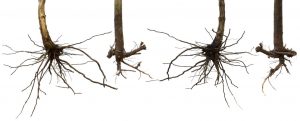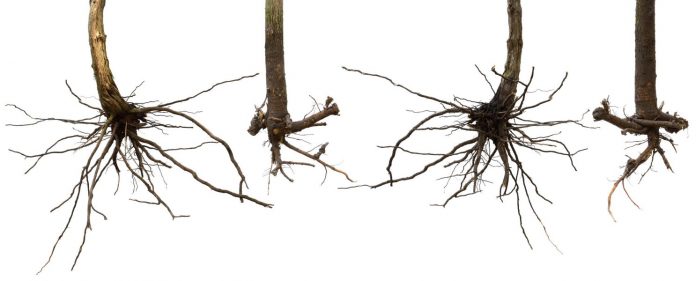 Those plant organs we call roots get their start in life as a tiny stringy structure called a radicle, at the non-leaf end of the baby plant, nestled with its food supply inside a seed.
Those plant organs we call roots get their start in life as a tiny stringy structure called a radicle, at the non-leaf end of the baby plant, nestled with its food supply inside a seed.
If Mother Nature is anything at all, she is efficient at packing next year’s fruits and vegetables in such insignificant looking containers.
That first lone root wakens, elongates and pushes through the deteriorating seed coat, which was softened up in damp soil. All roots absorb water and dissolved minerals to feed the plant of which they are a part. At no point do true roots have buds or leaves. Their job description is to push into the soil and absorb stuff.
Roots form at a plant part called its stem node.
For example, that onion core we toss out when cooking is a big node called a growth plate. Roots shoot out of the growth plate’s underside. Juicy, mostly colorless, leaves form a ball on the plate’s topside. The leaves surround a stem that will emerge into daylight with what we recognize as green leaves.
We’re always trying to keep our harvested onions dormant, but if they sit too long somewhere in the kitchen, the first thing we know they’re growing again. Refrigerated green onions in a plastic bag are poster children for sprouting roots.
When the baby plant’s radicle elongates and becomes the absorption bigwig, it gets labeled a taproot. Carrots are big taproots; so are radishes, beets and parsnips. Growers pretty them up for sale by removing their little secondary roots.
Under the root’s skin, or epidermis, things get more complicated than you might think. The tip, also called its meristem, is the nursery where new cells are born by means of cell division.
Right behind the nursery is the busy preschool or elongation zone. Here, new cells decide to be storage bins– or part of tubes– that transport dissolved soil minerals up to the stem, or organic matter down from the stem.
For organisms without a central nervous system, plants are pretty intelligent, no?
Grown-up root cells work and play in the mature cell mass behind the elongation zone. The skin enclosing the mature root cell mass produces root hairs which increase the organ’s ability to absorb nature’s bounty.
Some guys with diplomas and lab microscopes claim roots actually release proteins and sugars into the surrounding soil. Of course, local bacteria appreciate these handouts and a lot of larger organisms eat the bacteria, so healthy roots in the soil are a win for everyone below and above ground.
Around Feb. 15, the 2017 gun goes off for garden planting in north central Texas. This will be the time to put in carrot, beet and pea seeds. They wake up in chilly soil, air and water, but be patient; because this can take a couple of weeks. Keep things damp and don’t apply mulch until the seedlings are a few inches above ground.
That’s a good date to try your hand at potatoes, too. I also plant seedling lettuces, spinach, cauliflower and broccoli during the second half of February.
If a hard frost barrels in to your garden’s direction, give everything a good drink then cover the green parts. I use leaves if I have a bag handy, but there are all kinds of workable techniques. When the sun comes back out, throw off the covers.
If you need advice, call the Denton County Extension office at 940-349-2892.










 GIF.gif)





